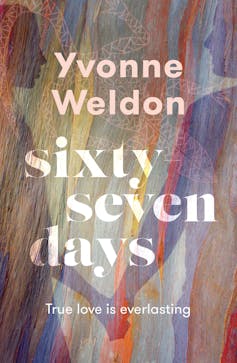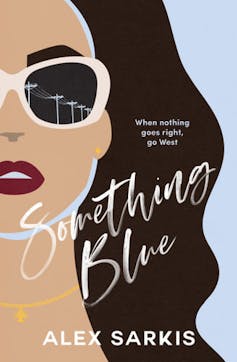
Romance is a genre of tropes — enemies to lovers, friends to lovers, stuck together, fake relationships — with a preference for a certain type of heroine: a young woman who is idealistic yet flawed, and “white, middle-class, heterosexual, young and single”.
But a TikTok rom-com boom and recent reader demands for diverse storytelling seem to be having an effect. New romance titles starring bold, culturally connected heroines – who manage to break genre moulds while remaining faithful to what readers love about romance – are starting to hit the market.
Review: Sixty-Seven Days by Yvonne Weldon (Penguin); Something Blue by Alex Sarkis (Ultimo)
There’s been a flood of diverse romance coming out every month internationally, with titles like Akwaeke Emezi’s You Made a Fool of Death With Your Beauty and Nisha Sharma’s Dating Dr. Dil. Australian publishers have so far been slow to catch up. But two new debut novels, Sixty-Seven Days by Yvonne Weldon and Something Blue by Alex Sarkis, could herald a new boom of diverse Australian romantic heroines.
Sparks fly in the wake of trauma
Yvonne Weldon is a proud Wiradjuri woman with an impressive list of credits to her name. She is the 2022 Aboriginal Woman of the year, the first ever Aboriginal councillor for the City of Sydney, and the first Aboriginal candidate to nominate for Lord Mayor of Sydney. Now, she adds author to her list of achievements.
Sixty-Seven Days is the story of Evie, a 19-year-old Wiradjuri woman who struggles with depression after experiencing a traumatic assault as a girl. Although she has strong family and cultural ties, Evie has struggled to work through what she experienced and has moved between jobs and university courses feeling unsettled, struggling with dark thoughts and sometimes wishing she were no longer alive.
Recovery is made even more difficult by the fact that the man who attacked her in her youth, a man she refers to as her predator, is also connected to the close-knit Redfern Aboriginal community. This means he’s an often unavoidable presence in her own family.
One summer day, Evie meets electrician’s apprentice James, and they fall deeply in love. It’s a magical connection where sparks almost literally fly whenever they’re in each other’s presence, in a way that neither of them can quite understand.
Their extraordinary romance fills the dark corners of Evie’s world with light. James’s presence often helps her feel protected (even when faced with her predator). His love helps to draw Evie from hopelessness and despair to a place where she is happy and excited about her future. But this is a romantic tragedy, and James and Evie’s love story lasts just 67 days before a heartbreaking turn of events tears them apart.
Read more: Love and a happy ending: romance fiction to help you through a coronavirus lockdown
Appetite for diverse voices
It’s no secret that there’s an increased appetite for more diverse voices in Australian literature. As an emerging Blak writer myself, it’s exciting to see new works published in genres where there hasn’t been a strong presence before. Anita Heiss paved the way in Aboriginal romance with her “choc lit” titles, such as Not Meeting Mr Right and Manhattan Dreaming. But here, Weldon is working in niche territory – a contemporary (if the 1990s can be “contemporary”) tragic love story, with a central plot driven entirely by culture and spiritual practice. When Weldon writes Country and Culture, the words seem to sing from the page:
We are being hugged from the grey mangroves where the trunks reach out over us and under us […] We take each step as if we are floating again to the sounds of the birds, the breeze and the ocean hitting the rocks in the background. We blindly walk but our feet do not hit the path – the dirt touches our feet.

James — a descendant of the stolen generations, whose family line and connections are uncertain — isn’t connected to culture in the same way as Evie. But his respect for her family, their ways, and their Country is a lovely touch that will ring true for many disconnected Indigenous peoples. He has a gentle hunger for her knowledge that (more than his role as her protector – which can get a little overbearing at times) will make readers fall for him as her love interest. He says:
I can’t say I’ve seen anything like this before, but I can feel the spirituality of this […] I’ve grown up without knowing my people and haven’t been immersed into culture with mob like you: what we are seeing is what I have waited my whole life for.
Drawing from ‘very real’ cultural beliefs
This is a love story written in a very Aboriginal way – a way non-Indigenous readers might describe as having a touch of the supernatural – but to describe the book as such (or as myth, or magic realism for that matter) would be structural racism that disrespects moe than 60,000 years of culture.
This is a book that draws from very real cultural beliefs. The way Weldon has woven Dreaming and Wiradjuri spirituality into the narrative allows for ancestors and family, even those who have long passed, to be very present throughout – in a way that will become intrinsically important for Evie.
Weldon beautifully expresses ideas of non-linear time and the way in which the Dreaming, past, and future work for Blakfullas. I often send non-Indigenous readers looking for a deeper understanding of our connection with time to Nardi Simpson’s Song of the Crocodile. I know that I will now add Sixty-Seven Days to my recommendation list.
Culture, for me, is the book’s strongest quality. But when Evie and James travel to her ancestral Country in the middle of the story, the pace slows substantially. The tension of the impending tragedy and the darkness of Evie’s past almost completely drops away – and without this, the story lacks a hook to keep readers engaged.
Similarly, the short, sharp chapters divided into each of the couple’s 67 days together don’t allow the reader a lot of connection to the characters, or the deep relationships they’re forming with Evie’s family and culture. Unfortunately, this means some of the book’s more heartbreaking aspects don’t quite hit the satisfying emotional peak that readers long for in romantic tragedies.
Evie and James’s love becomes all-encompassing very quickly. Romance readers, particularly those who are a fan of the tragic, doomed love story (think Romeo and Juliet, or perhaps more contemporarily, Nicholas Sparks’ oeuvre), will love this book. But the constant sweet-talking, pet names, and inability to spend time apart sometimes feels overbearing:
When we’re together there’s this glow of wanting to do as much as we can because the love we feel makes us want to grow it more, to expand it to all of us and what we do. It blends when we are together and contracts when we are apart. I can’t describe the intensity of it because there is a compounding light of one female soul and one male soul, our bodies enmeshed.
With Evie’s traumatic past, I found myself wanting to see her make her own way in the world: to bring herself from darkness into recovery with the support of her culture and family. But when recovery happens, it’s born of Evie’s reliance on James. Perhaps it’s because as a reader, I favour romantic comedies over tragedy, but I found the latter, more plot-driven chapters – where Evie has to make her own way through the world – the most satisfying parts of the story.
The millennial answer to Looking for Alibrandi
Alex Sarkis’s Something Blue is billed as the millennial answer to Looking for Alibrandi. Sarkis was born and raised in Sydney’s West, to Lebanese immigrant parents. Her book reads as a love letter to her culture and her home town – and the people who live there.

Part romance, part coming-of-age story and part social comedy, the story follows 26-year-old Nicole Najim. Nicole is nursing a recent heartbreak. Her appetite is gone, she feels stuck in her job at her family’s luxury car dealership, and now that her boyfriend has cheated and left her, the expectation (from her family and culture) that she get married, settle down and start a family seems almost impossible to meet.
It’s difficult to talk about Nicole’s love interest without spoiling the book, but I can say he’s as complex a character as any other. While he is every bit the romantic hero – rich, handsome, enigmatic; in plain sight all along — readers will definitely have lots of conflicting feelings about him.
There’s a huge cast of characters: Nicole’s parents, grandmother, aunties, uncles, cousins, childhood friends, and their families – even their hairdressers. But despite the volume of characters, Sarkis introduces each person perfectly and readers won’t have any problem distinguishing between them – even one of the hairdressers, who only pops up three times and is referred to as “the idiot with the eyebrows”, feels distinct. These very minor characters and the Western Sydney suburbs they inhabit play important roles in Nicole’s story.
Once an aspiring photographer with dreams of capturing images of “ordinary people in extraordinary places” like Paris and Rome, Nicole instead finds herself taking pictures of the cars for sale at her family’s dealership. But after she falls ill at work and is forced into a period of leave, she finds direction by documenting the lives of her community. She hopes to take pictures that tell her story and submit them to a selective workshop program run by a famous photographer she’s long admired.
By taking photos of her family and community, Nicole begins to truly see those around her in a way she didn’t before. It’s through truly knowing her community that Nicole is able to capture it. The plotline risks cliche, but Sarkis avoids this potential trap by making Nicole’s interactions feel deeply authentic.
For example, there’s the overconfident, rich DJ-turned-real-estate-developer Dave Dollaz, who is “heaps keen” on Nicole after seeing her at a family wedding. Reluctantly, Nicole agrees to a date, where Dave pulls out every stereotypical (and some not-so-stereotypical) move from the alpha male dating handbook: ordering food for her, bragging about his money.
Later, Dave shows Nicole his softer side and though he (almost disappointingly) doesn’t become the romantic lead, he does grow as a character before his moment comes to be photographically captured.

As with Sixty-Seven Days, place and culture are some of the strongest elements of Something Blue. It’s refreshing to read about Sydney from the perspective of suburbs like Granville and Bankstown, with their tight-knit cultural communities. To be shown into the Maronite Church for a variety of events, to see a Lebanese wedding reception, go to a glamorous fashion launch, and then a backyard barbecue where the host’s family mingles with a bunch of criminals – it feels like being invited into the community.
Walking through the streets of ultra-religious Granville to see Vote No billboards during the marriage equality debate is hard, but eye-opening. And it’s heartbreaking to see how the gentrification of suburbs like Bankstown affects residents who have found refuge, safety and community there – displacing people who are often in Australia because they were displaced in their birth countries.
It’s clear Sarkis loves the place she comes from: every suburb, street, home and hair salon is written with affection for the people and culture it represents.
Read more: A writer’s craft: a conversation with Melina Marchetta
More please!
These two very different novels share similar strengths. Both writers embed stories about what it’s like to fall in love within loving portrayals of their cultures, the places they come from, and family. I’m looking forward to seeing where both of these authors go with their storytelling – carrying their obvious connection to, care, and love for culture into future works.
I am a recipient of a 2021 Penguin Random House Write-It Fellowship and have worked with the editorial team who produced Weldon's novel 'Sixty-Seven Days'.
This article was originally published on The Conversation. Read the original article.







